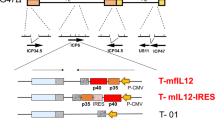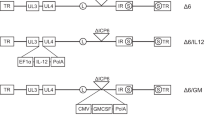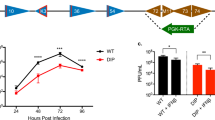Abstract
Many gene therapy strategies would be enhanced by efficient transfer of multiple genes into the same cell. Herpes simplex viral amplicon (HSV) vectors are good vehicles for gene transfer because they accommodate large pieces of foreign DNA and transfer genes rapidly and efficiently. The current studies examine whether efficient cotransduction of tumor cells can be accomplished using multiple HSV vectors in a manner useful for clinical gene therapy. Interleukin-12 (IL-12) exists as a heterodimer, with components (m35 and m40) coded for by genes on two separate chromosomes. We constructed HSV vectors carrying either IL12m35 (HSVm35) or IL12m40 (HSVm40) or both genes (HSVm75) separated by an internal ribosome entry site to assess whether gene transfer using a single HSV vector constructed to carry multiple genes has any advantage over gene transfer using multiple vectors that are each carrying single genes. Because IL-12 and IL-2 have been found to have synergistic antitumoral activity, we further analyzed the biologic activity of tumor cells cotransduced by separate HSV vectors carrying genes coding for these two cytokines. The results demonstrate that multiple genes can be inserted into the same cell efficiently using multiple HSV vectors, and that these vectors allow rapid production of tumor vaccines expressing multiple cytokine genes. Thus, gene transfer using HSV may not be limited by the size of the DNA that each vector can accommodate. Immunizations with tumors cotransduced with HSVm35 and HSVm40 were equally effective in eliciting a cytolytic T-lymphocyte response and in protecting against tumor growth in vivo as immunization with tumors treated with HSVm75. Immunization with tumors cotransduced with HSVm75 and HSVil2 was superior to immunization with tumors transduced with either alone. The combination of IL-2- and IL-12-secreting tumor cells may be used as an effective immunization strategy against solid tumors.
This is a preview of subscription content, access via your institution
Access options
Subscribe to this journal
Receive 12 print issues and online access
$259.00 per year
only $21.58 per issue
Buy this article
- Purchase on Springer Link
- Instant access to full article PDF
Prices may be subject to local taxes which are calculated during checkout
Similar content being viewed by others
Author information
Authors and Affiliations
Corresponding author
Rights and permissions
About this article
Cite this article
Karpoff, H., Kooby, D., D'Angelica, M. et al. Efficient cotransduction of tumors by multiple herpes simplex vectors: Implications for tumor vaccine production. Cancer Gene Ther 7, 581–588 (2000). https://doi.org/10.1038/sj.cgt.7700135
Received:
Accepted:
Published:
Issue Date:
DOI: https://doi.org/10.1038/sj.cgt.7700135
Keywords
This article is cited by
-
Immunotherapy with SLPI over-expressing mammary tumor cells decreases tumor growth
Cancer Immunology, Immunotherapy (2011)



